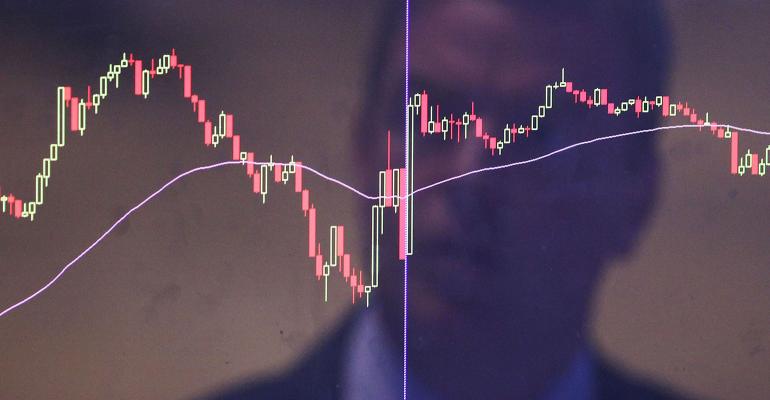By Mohamed A. El-Erian
(Bloomberg View) --The most commonly-cited reasons for the surge of interest in passive investing products are fee savings and skepticism about the ability of active funds to outperform. Most likely, these two factors explain a dominant part of the record flow into an ever-widening range of these investments, including mutual funds and ETFs. But they may not be the only reasons.
For some large investors, passive products increasingly serve as attractive proxies for a strategy that maintains a claim on the upside but also offers the possibility of a quick and cost-effective exit should elevated asset prices not be validated by improving fundamentals. And the more this set of investors grows, the larger the potential fallacy of composition (that is, what makes sense for some does not make sense for all), especially when applied to markets that lack structural liquidity (such as segments of high-yield and emerging markets).
As has been often noted, the current multiyear rally in stocks, one of the most impressive in history, has tended to be "unloved." It was embraced very slowly, extremely cautiously and only partially. The reasons were understandable: First, the trauma of the 2008-09 global stock-market selloff that preceded it. And second, the lack of progress until this year on economic policies that could validate over the longer-term what essentially had been a huge liquidity-driven phenomenon (whether due to central bank injections under unconventional policies or to the deployment of large corporate cash balances to buy back stocks and increase dividends).
Economic developments and prospects have also played a role. For several years, investors have been operating in what I have called the "yes, but" paradigm. Yes, the economy has been growing and corporate profits have been doing well but this has come with unusual economic, financial, political and geopolitical uncertainty.
Both aspects of this dynamic have intensified this year.
The "yes" part is bolstered by the synchronized pickup in global growth as a faster expansion in the U.S. -- including third-quarter annualized growth of 3.5 percent announced Thursday -- is matched by improvements in Europe and Japan and a smooth landing in China. Progress is being made in the U.S. on pro-growth policy, opening up a bigger window for the "beautiful normalization" of the Federal Reserve's unconventional policies. And the intense political concern in Europe has given way to excitement about the election of President Emmanuel Macron in France and the likelihood that Chancellor Angela Merkel will head a new coalition in Germany.
The "but" includes economic puzzles linked to wages, productivity and inflation. It also is reflected in global foreign-exchange markets in which no country seems able and/or willing to sustain a notably appreciated currency and in questions about what happens if four systemically important central banks (the Fed, European Central Bank, Bank of Japan and People's Bank of China) try to exit their unconventional monetary policies at the same time. The higher geopolitical risks include North Korea's increasingly brazen and provocative missile launches.
This "yes, but" configuration would tend to call for barbell-shaped investment strategies, especially given the current level of asset prices in public markets. It would require reallocating some of the exposure in public markets to higher risk, lower liquidity exposures and safe cash equivalents -- in other words, combining an upside on the considerable returns associated with the "yes" side (the right tail) with the ability to navigate a much less favorable state of the world (the left tail) should the "buts" prevail.
But, from a practical perspective, this strategy can also be hard to implement directly, particularly when it comes to the right tail. As such, small and, increasingly, some large investors have migrated to passive products, particularly ETFs, to proxy this approach. And the industry has responded by providing an ever-widening set of investments, some of which venture quite far from highly liquid market segments.
The more this non-bank "liquidity transformation" spreads via open-ended funds and ETFs, the greater the risk that the implicit promise of such investing -- of being able to reposition portfolios quickly and at reasonable bid-offer spreads -- becomes more tenuous should markets hit a big bump. In the process, the potential threat of contagion increases because history suggests that when investors lack liquidity in the products they wish to dispose of, they will feel compelled to sell other holdings.
Fortunately, and unlike during the run-up to the 2008 global financial crisis, this risk is outside the banking segment, far from the payments and settlement system, and generally not associated with irresponsible leverage levels. As such, it does not threaten to bring an economic "sudden stop." But it warrants close monitoring before it grows to pose a future threat to the higher and more inclusive economic expansion that is being targeted by policy makers and that is desired by citizens.
This column does not necessarily reflect the opinion of the editorial board or Bloomberg LP and its owners.
Mohamed A. El-Erian is a Bloomberg View columnist. He is the chief economic adviser at Allianz SE, the parent company of Pimco, where he served as CEO and co-CIO. He was chairman of the president's Global Development Council, CEO and president of Harvard Management Company, managing director at Salomon Smith Barney and deputy director of the IMF. His books include "The Only Game in Town" and "When Markets Collide."
To contact the author of this story: Mohamed A. El-Erian at [email protected] To contact the editor responsible for this story: Max Berley at [email protected]
For more columns from Bloomberg View, visit Bloomberg view





